Echoes of My Soul (20 page)
Authors: Robert K. Tanenbaum

POSTSCRIPT
C
lassics are ageless. They don't wither in time. For them, there is no statute of limitations. They are intrinsically an expression and reflection of a value system and culture.
lassics are ageless. They don't wither in time. For them, there is no statute of limitations. They are intrinsically an expression and reflection of a value system and culture.
At their most compelling, they suggest a moral dimension that exists and ought to influence and determine the decisions that we make in our private and public lives. Certainly, public officials are mandated pursuant to our founding documents, the Declaration of Independence/Constitutionâtwo promissory notes, if you willâto be guided by and act consonant with these moral and legal precepts. Unfortunately, all too frequently, the historical experience suggests otherwise.
Yet, there are heroes amongst us. Frank Hogan, Mel Glass and John Keenan qualify, in my judgment, as Arthurian knights of the Round Table. From them, I witnessed up close and personal the actual functioning of the inner sanctum of a ministry of justice operating on a case-by-case, qualitative analytical, apolitical merit-driven basis.
DA Frank Hogan was truly a legend long before Wylie-Hoffert occurred. Once convinced that Mel Glass's gut instincts and subsequent investigation were legit, and that George Whitmore Jr. was wrongfully indicted for the most gruesome and sensationalized double murders and rape in the media's radar, Hogan was prepared to admit his mistake, possibly fracture his career's reputation and exonerate an impoverished young man with an IQ lower than 70. And why? Simply and manifestly, because it was right; justice demanded it.
I first met Mel Glass and Frank Hogan during the interview hiring process. After my interview with Mel, I was sent to Hogan for final evaluation based upon his recommendation.
Having just graduated from law school at Berkeley, I returned home to New York, took the bar and started working at the Manhattan DA's Office. For the first three years of my tenure, I served in the Complaint and Criminal Courts Bureaus, mentored by my bureau chief, Mel Glass. He instilled in me the basics, the fundamentals of the blocking and tackling of precisely how to administer justice. He always held firm to the ideal that the two most important responsibilities of the DA are to exonerate the unjustly accused and proceed to prosecution only when there is unquestioned factual guilt corroborated by legally admissible evidence sufficient to convict the defendant beyond a reasonable doubt.
Mel Glass always avoided media exploitation. He never sought to capitalize monetarily or otherwise from, as he put it, “simply doing my job.” After the conviction of Richard Robles in Wylie-Hoffert, Mel turned down an offer of $150,000 from
Life
magazine to reveal the “real” inside story.
Life
magazine to reveal the “real” inside story.
After several years I graduated from Mel's tutelage, while serving in the Criminal Courts Bureau, to the elite corps, the Homicide Bureau. There I was mentored by John Keenan. How fortunate was I to be trained by Mel Glass and John Keenan? Sort of like playing at Notre Dame under Ara Parseghian and then to Green Bay coached by Vince Lombardi.
From Mel, it was all about the basics; from Keenan, it was the precision, drama and art of trial practice. He was truly a master, without equal.
To Frank Hogan, Mel Glass and John Keenan, I owe my professional career.
Approximately four years ago, Mel asked me to write this book. After all that had been written, he wanted the true story to be known. He supplied me with the actual trial transcripts, some of which is quoted in
Echoes of My Soul,
crime scene photos, police reports, autopsy protocols, his contemporaneous notes and other investigative material. Most valuable, however, were his insights and detailed recollections of the events. We spent countless months going over the material, which was voluminous. Throughout all the time we shared going over the case, his only admonition was that I must always remain
objective.
I have endeavored to do just that.
Echoes of My Soul,
crime scene photos, police reports, autopsy protocols, his contemporaneous notes and other investigative material. Most valuable, however, were his insights and detailed recollections of the events. We spent countless months going over the material, which was voluminous. Throughout all the time we shared going over the case, his only admonition was that I must always remain
objective.
I have endeavored to do just that.
On one level
Echoes of My Soul
speaks volumes about how a committed individual, Mel Glass, can make a huge impact. A triumphant, uplifting justice victory delivered by a dedicated young Hogan acolyte, whose soul was pure, intact and righteous.
Echoes of My Soul
speaks volumes about how a committed individual, Mel Glass, can make a huge impact. A triumphant, uplifting justice victory delivered by a dedicated young Hogan acolyte, whose soul was pure, intact and righteous.
Yet
Echoes of My Soul
is much more meaningful. To do justice in our lives, to be civil, tolerant, rational and forthright is to enhance the dignity not only of ourselves but of the public office we may occupy, the job we hold and the culture in which we thrive. Those values are timeless. We need to experience them so that we may always be reminded who we are and from where we came. When faced with cultural coarsening, we seek affirmation of triumph.
Echoes of My Soul
satisfies that need.
Echoes of My Soul
is much more meaningful. To do justice in our lives, to be civil, tolerant, rational and forthright is to enhance the dignity not only of ourselves but of the public office we may occupy, the job we hold and the culture in which we thrive. Those values are timeless. We need to experience them so that we may always be reminded who we are and from where we came. When faced with cultural coarsening, we seek affirmation of triumph.
Echoes of My Soul
satisfies that need.
Sometimes it is necessary to remind ourselves of the authenticity of American exceptionalism. We are a moral people. We attempt to institutionalize virtue. We recognize that evil exists and it must be confronted and defeated.
Mel Glass, John Keenan and Frank Hogan made decisions that were morally inspired. They embodied and personified the spiritual essence of American exceptionalism.
The path they placed me on was paved with principle and integrity that led to justice. That's the stuff, the foundational basis, upon which a “Ministry of Justice” is constructed. For granting me this invaluable experience, I am, and will be, forever grateful.
ECHOES OF MY SOUL
Â
Â
NOTE
Â
The following names of individuals have been changed
and are not their real names:
and are not their real names:
Â
Vic Arena
Louie Ayala
Frank Backer
Mack Dollinger
Alma Estrada
Ricky Getz
Liam Gynt
Harry Hart
Jennifer Holley
James Hosty
Tim Krupa
Harold Lasky
Lenny Meyers
Tommy Micelli
Abbe Mills (Abbe Romano)
Dr. Morris
Katherine “Kate” Olsen (Fagen)
Peter
Dr. Lucille St. Helme
Louie Ayala
Frank Backer
Mack Dollinger
Alma Estrada
Ricky Getz
Liam Gynt
Harry Hart
Jennifer Holley
James Hosty
Tim Krupa
Harold Lasky
Lenny Meyers
Tommy Micelli
Abbe Mills (Abbe Romano)
Dr. Morris
Katherine “Kate” Olsen (Fagen)
Peter
Dr. Lucille St. Helme

Janice Wylie and Emily Hoffert were slain in their apartment on Manhattan's Upper East Side on August 28, 1963.
(
New York Daily News
/Getty)
(
New York Daily News
/Getty)
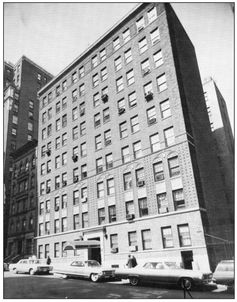
The front of their building at 57 East 88th Street, looking west.

The entrance to the victims' residence.

The double doors leading into their building.

The lobby of 57 East 88th Street, showing the door that led to the service area. Access to this door became an important issue at the murder trial.

The bedroom where the murders took place. A knifeâone of the murder weaponsâis seen on the radiator (circled).

The victims, partially covered with a blue blanket placed on their bodies by Janice's father Max Wylie when he found them. The clock radio, unplugged by the killer, showed the time as 10:35. Emily's glasses are on the bed, and the handle of the knife is seen on the radiator.
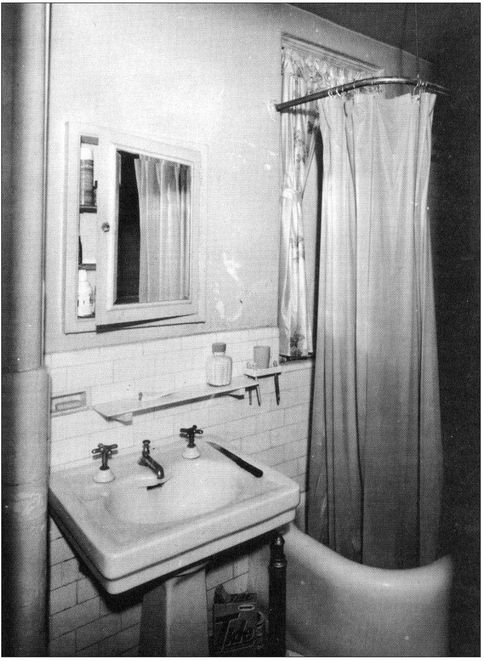
The bathroom located near the bedroom where the bodies of Janice Wylie and Emily Hoffert were found. Note one of the murder weapons that the killer placed on the bathroom sink.
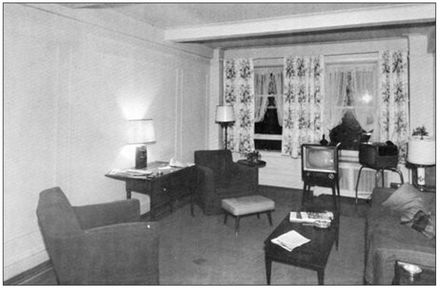
The living room, facing the windows. The TV was on to show Martin Luther King, Jr., delivering his historic “I Have a Dream” speech in Washington, D.C.

The living room, opposite view, facing the door to the apartment's hallway.
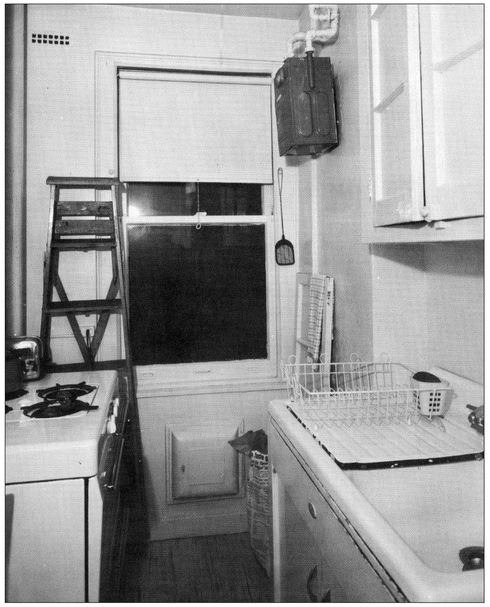
Interior view of the kitchen window in Apt. 3C. The killer entered the apartment through this window.

This exterior shot shows the kitchen window of Apt. 3C, as well as the window of the service stairway, through which the killer exited to climb into the apartment. The numbers indicate the floors of the building.
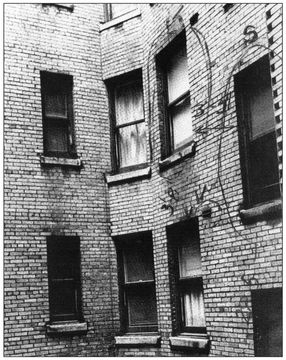
Exterior of the kitchen window of Apt. 3C. The handwritten notations were used in the courtroom to show the jury how the killer entered the apartment.
Other books
Buying His Bride (The Donovan Brothers Trilogy Book 1) by Alison Ashlyn
Enchanted Revenge by Theresa M. Jones
A Dangerous Arrangement by Lee Christine
Death of a Supertanker by Antony Trew
Calculated Risk by Zoe M. McCarthy
Murder on Gramercy Park by Victoria Thompson
Freya Stark by Caroline Moorehead
A Lady’s Lesson in Scandal by Meredith Duran
Between the Dark and the Daylight: Encountering and Embracing the Contradictions of Life by Joan Chittister, Osb, Joan Sister Chittister
